Rucks pit, Fort Drum, Florida
Rucks pit, Fort Drum, Florida
Rucks pit, Fort Drum, Florida

Rucks’s Pit (named after the Rucks family, the owners of the mine) is located in Fort Drum, Florida. Fort Drum is a little tiny town to the north of Lake Okeechobee. Lake Okeechobee is the really big lake in the middle of the state of Florida. The lake is famous for bass fishing.

Rucks’s Pit (named after the Rucks family, the owners of the mine) is located in Fort Drum, Florida. Fort Drum is a little tiny town to the north of Lake Okeechobee. Lake Okeechobee is the really big lake in the middle of the state of Florida. The lake is famous for bass fishing.

Rucks’s Pit (named after the Rucks family, the owners of the mine) is located in Fort Drum, Florida. Fort Drum is a little tiny town to the north of Lake Okeechobee. Lake Okeechobee is the really big lake in the middle of the state of Florida. The lake is famous for bass fishing.
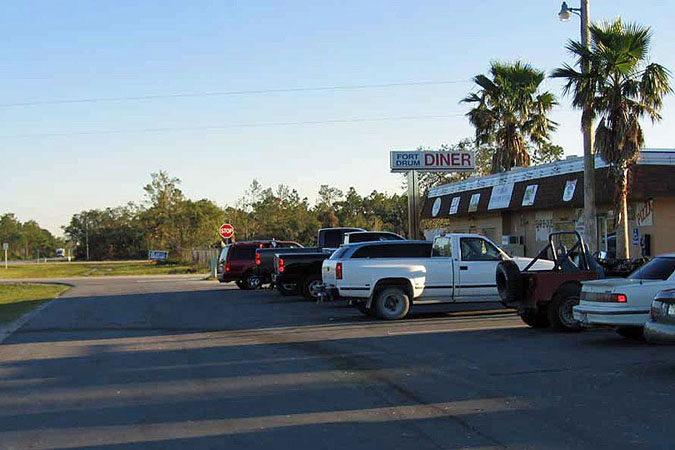
Fort Drum, on the other hand, is not very well known. While I was there, I asked my waitress (at the only restaurant in town) what people did for fun in Fort Drum. She said, "Oh, mudden’ and hoggen’." I didn’t know what she meant and had to ask for a clarification. Apparently, "mudden’" refers to putting really big tires on your truck and driving through the swamp. "Hoggen’" is the sport of hunting the feral hogs in the swamp --- they can be up to 1200 pounds with 8 inch tusks. The things you miss growing up in Connecticut...

Fort Drum, on the other hand, is not very well known. While I was there, I asked my waitress (at the only restaurant in town) what people did for fun in Fort Drum. She said, "Oh, mudden’ and hoggen’." I didn’t know what she meant and had to ask for a clarification. Apparently, "mudden’" refers to putting really big tires on your truck and driving through the swamp. "Hoggen’" is the sport of hunting the feral hogs in the swamp --- they can be up to 1200 pounds with 8 inch tusks. The things you miss growing up in Connecticut...

Fort Drum, on the other hand, is not very well known. While I was there, I asked my waitress (at the only restaurant in town) what people did for fun in Fort Drum. She said, "Oh, mudden’ and hoggen’." I didn’t know what she meant and had to ask for a clarification. Apparently, "mudden’" refers to putting really big tires on your truck and driving through the swamp. "Hoggen’" is the sport of hunting the feral hogs in the swamp --- they can be up to 1200 pounds with 8 inch tusks. The things you miss growing up in Connecticut...
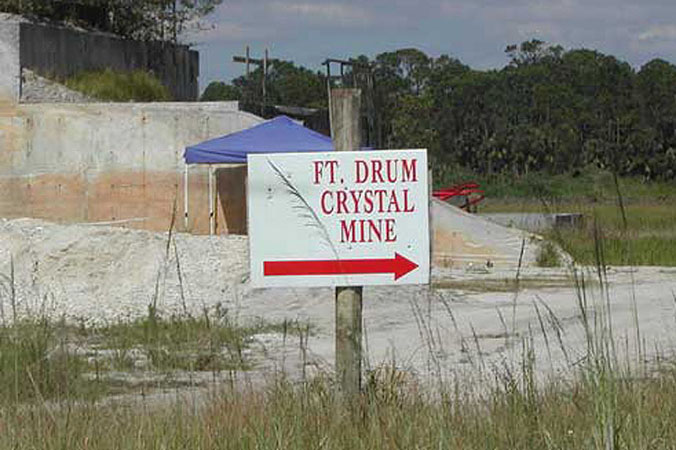
At any rate, Fort Drum is now on the map --- at least for fossil and mineral collectors.

At any rate, Fort Drum is now on the map --- at least for fossil and mineral collectors.

At any rate, Fort Drum is now on the map --- at least for fossil and mineral collectors.
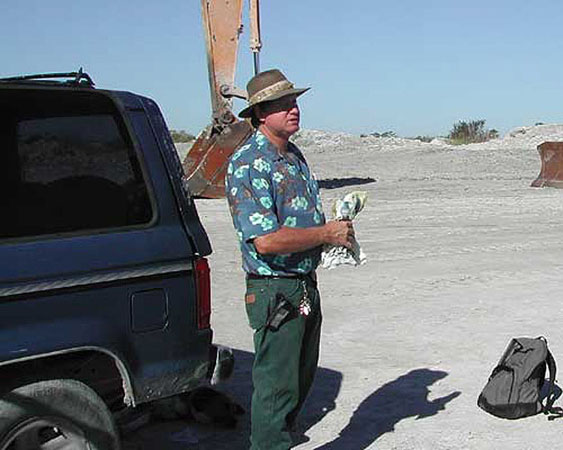
This is Eddie Rucks. He is the owner of the quarry. If you want to collect here, you need to speak to him.

This is Eddie Rucks. He is the owner of the quarry. If you want to collect here, you need to speak to him.

This is Eddie Rucks. He is the owner of the quarry. If you want to collect here, you need to speak to him.
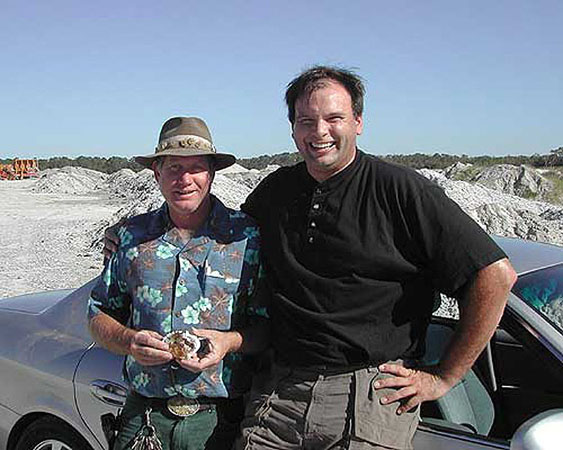
This is me and Eddie. He is a great guy. He spent a lot of time telling me about his quarry and showing me some of what’s been found there. He’s holding one nice specimen in his hand.

This is me and Eddie. He is a great guy. He spent a lot of time telling me about his quarry and showing me some of what’s been found there. He’s holding one nice specimen in his hand.

This is me and Eddie. He is a great guy. He spent a lot of time telling me about his quarry and showing me some of what’s been found there. He’s holding one nice specimen in his hand.

I’m not much of a fossil person, but Eddie told me quite a number of interesting fossils have been found in his quarry. His favorites are the cowries. Many specimens new to science have been found and described from Fort Drum.

I’m not much of a fossil person, but Eddie told me quite a number of interesting fossils have been found in his quarry. His favorites are the cowries. Many specimens new to science have been found and described from Fort Drum.

I’m not much of a fossil person, but Eddie told me quite a number of interesting fossils have been found in his quarry. His favorites are the cowries. Many specimens new to science have been found and described from Fort Drum.
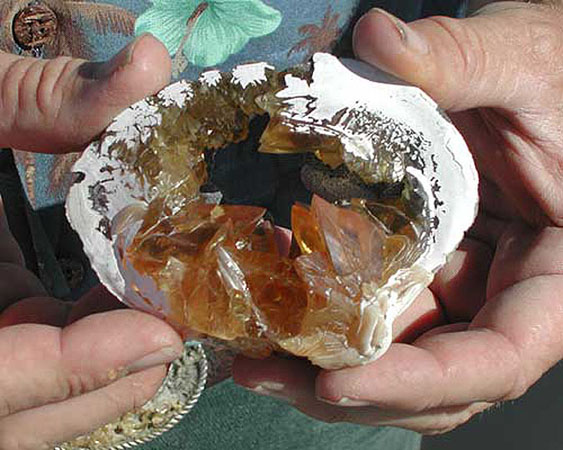
But there are more than just fossils to be found at Fort Drum! Look at this piece --- one of Eddie’s favorites. It is a fossil clam that has been partially disolved away and then partially filled in with AMAZING calcite crystals. I have seen fossil clams with calcite in them before, but never such big clams and especially not such big calcites! And look at the COLOR! People are actually faceting broken pieces of this calcite it has such good color.

But there are more than just fossils to be found at Fort Drum! Look at this piece --- one of Eddie’s favorites. It is a fossil clam that has been partially disolved away and then partially filled in with AMAZING calcite crystals. I have seen fossil clams with calcite in them before, but never such big clams and especially not such big calcites! And look at the COLOR! People are actually faceting broken pieces of this calcite it has such good color.

But there are more than just fossils to be found at Fort Drum! Look at this piece --- one of Eddie’s favorites. It is a fossil clam that has been partially disolved away and then partially filled in with AMAZING calcite crystals. I have seen fossil clams with calcite in them before, but never such big clams and especially not such big calcites! And look at the COLOR! People are actually faceting broken pieces of this calcite it has such good color.
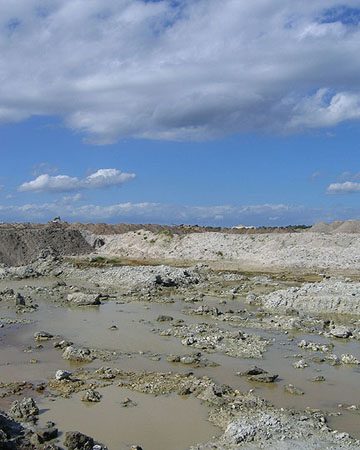
Here’s a view of the quarrying operation. The "rock" is being processed for use as a building material for roads, etc. When you get a close up look at the rock, it looks like a very, very porous (as much as 40% air!) limestone loaded with bits of crushed shell and sand, etc.

Here’s a view of the quarrying operation. The "rock" is being processed for use as a building material for roads, etc. When you get a close up look at the rock, it looks like a very, very porous (as much as 40% air!) limestone loaded with bits of crushed shell and sand, etc.

Here’s a view of the quarrying operation. The "rock" is being processed for use as a building material for roads, etc. When you get a close up look at the rock, it looks like a very, very porous (as much as 40% air!) limestone loaded with bits of crushed shell and sand, etc.
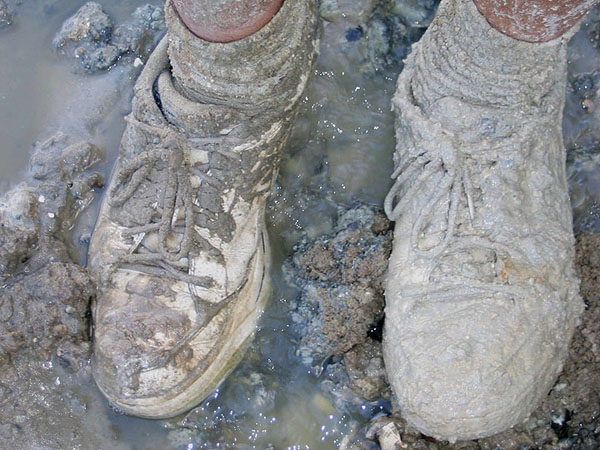
Let’s get our feet wet, shall we?

Let’s get our feet wet, shall we?

Let’s get our feet wet, shall we?

You’re going to need digging tools. The rock does not split like most rocks. It is so porous that chisels are useless --- they just sink into the rock. You need something to kind of cut through the rock. I found these tools to be useful.

You’re going to need digging tools. The rock does not split like most rocks. It is so porous that chisels are useless --- they just sink into the rock. You need something to kind of cut through the rock. I found these tools to be useful.

You’re going to need digging tools. The rock does not split like most rocks. It is so porous that chisels are useless --- they just sink into the rock. You need something to kind of cut through the rock. I found these tools to be useful.
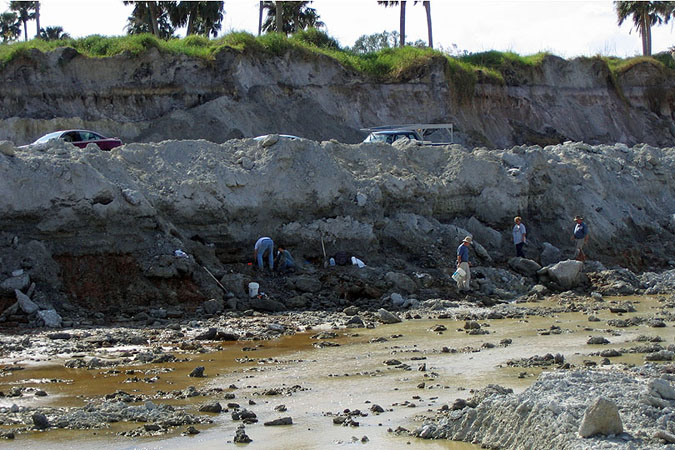
There are fossils in every layer of the quarry, but the big fossil clams with calcite occur only in one layer. Here’s a group of people working along the bank of the quarry looking for the clams. They’re all working the same horizontal layer about one third of the way up. Eddie used to let people dig in the quarry itself, but now he scoops up huge piles of the rock and dumps them on the side of the quarry (for *sigh* liablity reasons).

There are fossils in every layer of the quarry, but the big fossil clams with calcite occur only in one layer. Here’s a group of people working along the bank of the quarry looking for the clams. They’re all working the same horizontal layer about one third of the way up. Eddie used to let people dig in the quarry itself, but now he scoops up huge piles of the rock and dumps them on the side of the quarry (for *sigh* liablity reasons).

There are fossils in every layer of the quarry, but the big fossil clams with calcite occur only in one layer. Here’s a group of people working along the bank of the quarry looking for the clams. They’re all working the same horizontal layer about one third of the way up. Eddie used to let people dig in the quarry itself, but now he scoops up huge piles of the rock and dumps them on the side of the quarry (for *sigh* liablity reasons).
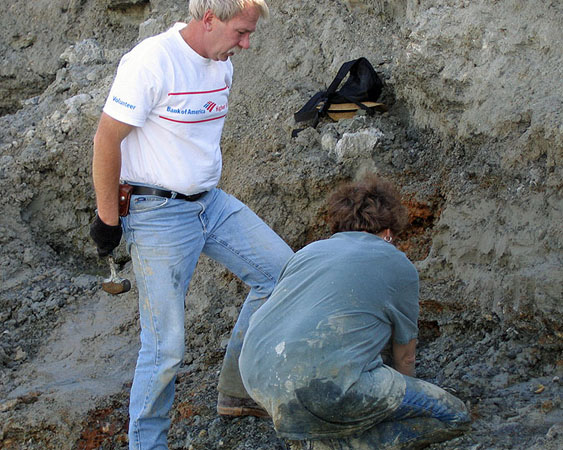
In this photo, Dave and Barbara are working hard to free some 3 million year old clams from their final resting place. Somehow I caught Dave’s worst side in this picture. And Barbara’s best...

In this photo, Dave and Barbara are working hard to free some 3 million year old clams from their final resting place. Somehow I caught Dave’s worst side in this picture. And Barbara’s best...

In this photo, Dave and Barbara are working hard to free some 3 million year old clams from their final resting place. Somehow I caught Dave’s worst side in this picture. And Barbara’s best...

Here I’m trying to find my own clams. By the way, I have no good side. At any rate, the hat is a must have working in this quarry. So is sunscreen. There ARE alligators in the pit (anyplace in Florida with water has alligators), but the sun is a bigger hazard.

Here I’m trying to find my own clams. By the way, I have no good side. At any rate, the hat is a must have working in this quarry. So is sunscreen. There ARE alligators in the pit (anyplace in Florida with water has alligators), but the sun is a bigger hazard.

Here I’m trying to find my own clams. By the way, I have no good side. At any rate, the hat is a must have working in this quarry. So is sunscreen. There ARE alligators in the pit (anyplace in Florida with water has alligators), but the sun is a bigger hazard.
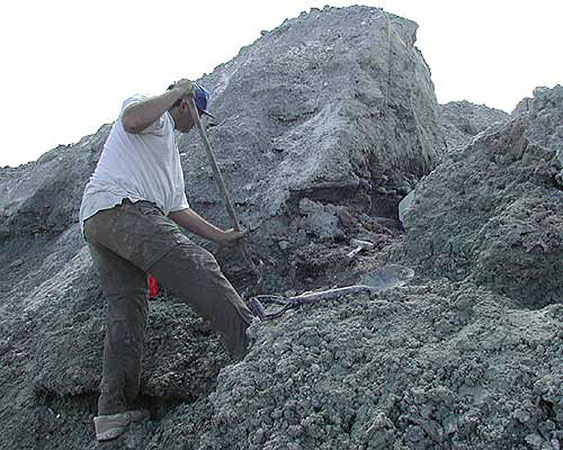
You need to dig to expose the fossil clam layer.

You need to dig to expose the fossil clam layer.

You need to dig to expose the fossil clam layer.
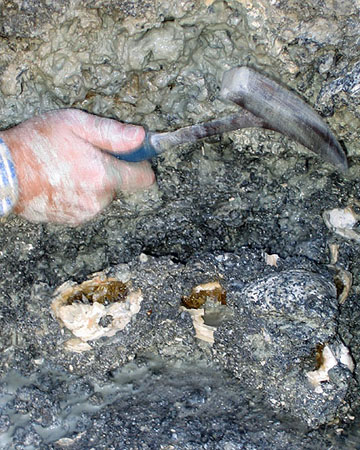
Another visitor to the quarry made good use of a geologist’s pick once he found a clam. It took him a while, but he was able to chip around the specimens he wanted and extract them in matrix without damage. This is the hardest part of collecting at Rucks’s pit --- calcite is very easy to damage.

Another visitor to the quarry made good use of a geologist’s pick once he found a clam. It took him a while, but he was able to chip around the specimens he wanted and extract them in matrix without damage. This is the hardest part of collecting at Rucks’s pit --- calcite is very easy to damage.

Another visitor to the quarry made good use of a geologist’s pick once he found a clam. It took him a while, but he was able to chip around the specimens he wanted and extract them in matrix without damage. This is the hardest part of collecting at Rucks’s pit --- calcite is very easy to damage.
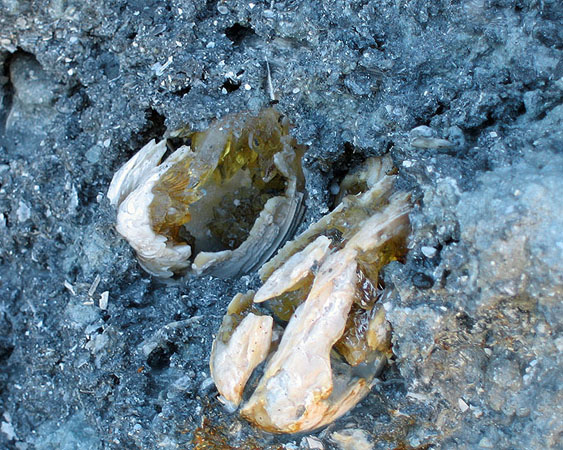
When you are digging in the right area, you will find whole beds of clams like these two. The neat thing is that all of the clams with calcite in them will be oriented the same way --- with the hinge near the top. This is a natural position for a living clam. If you find a clam lying on its side or oriented somehow randomly, it will almost always be hollow (meaning there are no calcites inside). What this says to me is that the clams were buried suddenly while still alive. For some reason, only the living clams formed calcite crystals --- empty shells buried at the same time never developed calcite. To me it suggests that the body of the animal actually had some effect on the formation of the calcite. I would love to hear from a geologist or someone who knows more about these things than I do to comment on this...

When you are digging in the right area, you will find whole beds of clams like these two. The neat thing is that all of the clams with calcite in them will be oriented the same way --- with the hinge near the top. This is a natural position for a living clam. If you find a clam lying on its side or oriented somehow randomly, it will almost always be hollow (meaning there are no calcites inside). What this says to me is that the clams were buried suddenly while still alive. For some reason, only the living clams formed calcite crystals --- empty shells buried at the same time never developed calcite. To me it suggests that the body of the animal actually had some effect on the formation of the calcite. I would love to hear from a geologist or someone who knows more about these things than I do to comment on this...

When you are digging in the right area, you will find whole beds of clams like these two. The neat thing is that all of the clams with calcite in them will be oriented the same way --- with the hinge near the top. This is a natural position for a living clam. If you find a clam lying on its side or oriented somehow randomly, it will almost always be hollow (meaning there are no calcites inside). What this says to me is that the clams were buried suddenly while still alive. For some reason, only the living clams formed calcite crystals --- empty shells buried at the same time never developed calcite. To me it suggests that the body of the animal actually had some effect on the formation of the calcite. I would love to hear from a geologist or someone who knows more about these things than I do to comment on this...
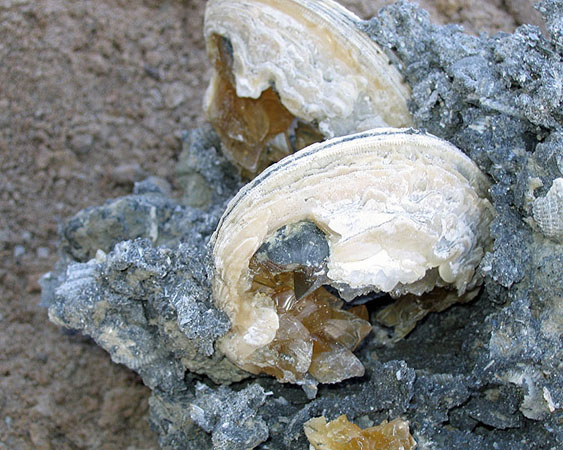
Here is a pretty cool matrix piece with two very well exposed clams. You have to be very careful trimming these specimens down. It is very easy to break the clam in half instead of trimming off the excess matrix. I have found a screwdrive can be used as a pry to break small pieces of matrix off. I still sometimes go to far --- I lost this specimen trimming it after spending a long time getting it out.

Here is a pretty cool matrix piece with two very well exposed clams. You have to be very careful trimming these specimens down. It is very easy to break the clam in half instead of trimming off the excess matrix. I have found a screwdrive can be used as a pry to break small pieces of matrix off. I still sometimes go to far --- I lost this specimen trimming it after spending a long time getting it out.

Here is a pretty cool matrix piece with two very well exposed clams. You have to be very careful trimming these specimens down. It is very easy to break the clam in half instead of trimming off the excess matrix. I have found a screwdrive can be used as a pry to break small pieces of matrix off. I still sometimes go to far --- I lost this specimen trimming it after spending a long time getting it out.

Make sure you bring plenty of packing material. The fossil clams are fragile and the calcite is even more fragile. The slightest bump will nick a calcite or break off a clam.

Make sure you bring plenty of packing material. The fossil clams are fragile and the calcite is even more fragile. The slightest bump will nick a calcite or break off a clam.

Make sure you bring plenty of packing material. The fossil clams are fragile and the calcite is even more fragile. The slightest bump will nick a calcite or break off a clam.
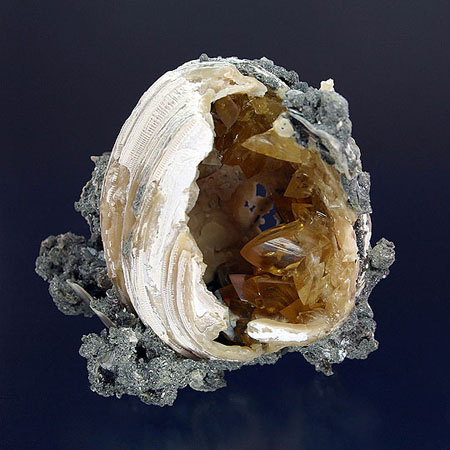
Here’s one of the specimens in my collection. It has exceptionally large clear calcites with deep amber color. If you are looking for a good specimen, try to find one with an unbroken arch and large, undamaged calcite crystals with good color. There are a lot of specimens out there, but it is so easy to damage either the calcite or the clam while you are collecting that a perfect specimen is clearly worth more. By the way, I did not break open this clamshell to reveal the calcite...this is the way these specimens are found. The shell has partially dissolved away and maybe the very same calcium carbonate that used to be in the shell has been re-deposited as calcite crystals. At any rate, you could not ask for a more beautiful fossil - mineral combination! Thanks Eddie!

Here’s one of the specimens in my collection. It has exceptionally large clear calcites with deep amber color. If you are looking for a good specimen, try to find one with an unbroken arch and large, undamaged calcite crystals with good color. There are a lot of specimens out there, but it is so easy to damage either the calcite or the clam while you are collecting that a perfect specimen is clearly worth more. By the way, I did not break open this clamshell to reveal the calcite...this is the way these specimens are found. The shell has partially dissolved away and maybe the very same calcium carbonate that used to be in the shell has been re-deposited as calcite crystals. At any rate, you could not ask for a more beautiful fossil - mineral combination! Thanks Eddie!

Here’s one of the specimens in my collection. It has exceptionally large clear calcites with deep amber color. If you are looking for a good specimen, try to find one with an unbroken arch and large, undamaged calcite crystals with good color. There are a lot of specimens out there, but it is so easy to damage either the calcite or the clam while you are collecting that a perfect specimen is clearly worth more. By the way, I did not break open this clamshell to reveal the calcite...this is the way these specimens are found. The shell has partially dissolved away and maybe the very same calcium carbonate that used to be in the shell has been re-deposited as calcite crystals. At any rate, you could not ask for a more beautiful fossil - mineral combination! Thanks Eddie!